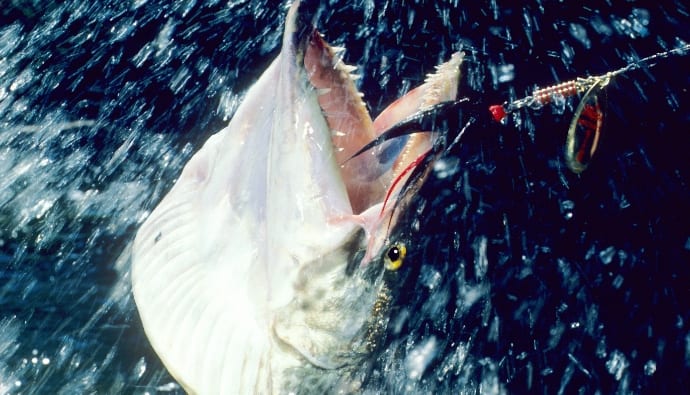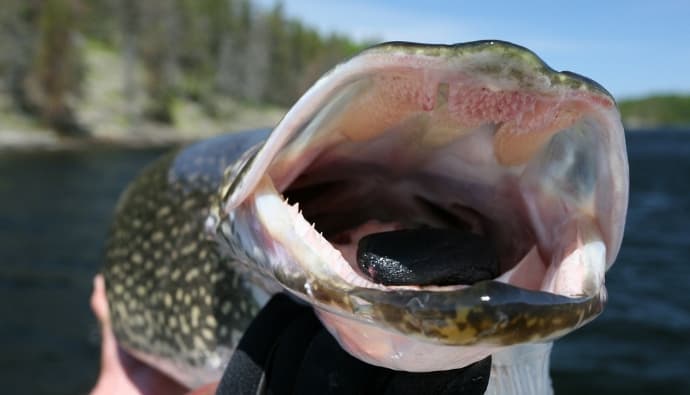Muskies are freshwater predators with hundreds of razor-sharp teeth to help them tear their prey. They have dozens of bigger canines and other small teeth arranged in rows. For example, grown-up muskies can have about 500 to 700 teeth in their mouth, and their biggest canine can range up to one inch in length. Muskie’s smaller teeth are curved inward to give them a better grip and prevent their prey fish from escaping. Additionally, their fang-like teeth are strategically located along the lower jaw and upper jaw to help them grab and hold their prey.
Muskies are popular freshwater fish in most of North America’s water bodies. Muskie teeth attract attention among many anglers. That’s why this article will shed more light on the anatomy and function of musky teeth and how you can handle them safely when musky fishing.

Anatomy and Function of Muskie Teeth
Anglers who have caught muskies can agree that you first see sharp, fang-like teeth protruding from their jawlines. However, when you open its mouth, you will find numerous other sharp teeth arranged in rows along the upper and lower jawlines.
How Many Teeth Do Muskies Have?
How many teeth a muskellunge has depends on age and size. For example, an adult muskie can have about 500 to 700 teeth. There are cases where larger muskies had more than 700 teeth.
Muskie’s smaller needle-like teeth are angled inward and can be found even on their tongue and the roof of their mouth. These teeth are adapted to prevent the prey from escaping.
Additionally, these smaller teeth help muskies to turn their prey so that they can swallow their head first. Their fang-like teeth are strategically located along the lower jaw and upper jaw to help them grab and hold their prey.
Once a muskie bites its prey fish, the small razor-sharp teeth shred and cut to make swallowing easier.
How Big Are Muskie Teeth?
The length of muskie teeth depends on their size. Generally, their canines can grow up to one inch. These canines are located at the muskie’s jaw and are primarily designed for hunting. They can hold their prey and push it inside their mouth.
Muskies have other smaller teeth ranging from 1/8 to 1/16 of an inch. These teeth are curved inward to give them a better grip and prevent their prey fish from escaping.
Do Muskies Lose Their Teeth?
There are cases where anglers catch muskies with missing teeth, which has made some wonder whether they lose their teeth. In general, most muskies don’t shed their teeth.
However, several reasons could make them lose their teeth. These reasons include old age, violent spawning behavior, feeding problems, and accidents. In most cases, the teeth they lose when feeding grow back as long as it’s still young and healthy.
Sometimes, your fellow anglers can catch muskies with few or no teeth. In most of these cases, the muskies are old or sick, and this rules out any myth that muskies shed their teeth naturally.
Handling Muskie Safely
Remember, muskies are dangerous, so you should handle them safely to avoid getting a muskie bite. Some of the safety equipment you should carry include:
- A hook out
- A hook cutter
- Fish-friendly jaw spreaders
- Long needle-nose pliers
- A landing net
Follow the steps below to unhook a musky safely.
Step 1: Use a Landing Net to Scoop the Fish
Use a landing net to minimize the time you’re in contact with muskies. This is also a good option, especially if you’re doing catch-and-release fishing.
Step 2: Cut the Wire Leader
If you used a main or leader, cut it to separate your fish from the rest of your fishing gear. Once done, place your fingers inside the musky gill plate to unhook it. Be careful when inserting your fingers in muskie’s gills because they are sharp and can tear your skin.
Step 3: Unhook the Fish
Unhooking the fish requires patience and alertness. A single mistake can make your hand land in their teeth. Big muskies usually have long fangs and can easily pin you when removing the hook, so using teeth-proof gloves is advisable.
Step 3: Safely Grip the Fish
Even after unhooking it, musky teeth can still harm you. Ideally, support the fish with both hands and ensure some of their parts are slightly in the water, especially if you’re doing catch-and-release fishing.
Recommended Fishing Gear
Muskies are aggressive predators and can easily shred braided lines. You can use a fluorocarbon line, but it has to be thick enough to withstand the impact. Ideally, you should use it alongside a strong wire leader.
A fluorocarbon line is made of a tough material that doesn’t refract light, so it will be nearly invisible when used for musky fishing.
Choosing a one and a half foot leader made with fluorocarbon material with a thickness of at least 0.80 to 1.0 mm in diameter is advisable. Also, you can use a titanium wire leader for larger muskies because it’s designed for toothy fish.
Although fluorocarbon line leaders are a bit costlier than other options, they are the best option as they’re durable and will serve you more. Always ensure you inspect your fluorocarbon leaders to identify and correct weak points.
Do Muskies Attack Humans?
There are claims stating that muskies attack humans. Of course, this is true as musky can occasionally attack anglers and swimmers, but it’s rare.
You will get musky’s toothy bite when they mistake your body parts for food or when you don’t handle them carefully when removing the lure in their mouth.
What Should I Do If I Get Cut by a Muskie?
Muskie’s mouth is full of teeth that are sharp and might be carrying bacteria. In case you get a bite, do the following.
- Detach your hand or fingers using long nose pliers, a jaw spreader, and an unhooking mat to loosen the fish teeth grip.
- Once your body part is free, apply enough pressure to stop the bleeding.
- Clean the wound with saline water and apply an anti-bacterial paste or gel to eliminate germs.
- Cover the wound with a clean rag, towel, or surgical gauze. This prevents the wound from getting further infections and dirt.
- Visit your doctor to determine the seriousness of the injury. Some bites are too deep, and they might need to be stitched.
Always bring a first aid kit to clean and dress the wound to prevent infections. Using tooth-proof gloves when removing your lure is advisable to avoid such bites in the future.
Conclusion
Muskies have dozens of bigger canines and numerous teeth arranged in a row. On average, an adult musky can have about 500 to 700 teeth.
Muskies have fang-like teeth strategically located along the lower jaw and upper jaw to help them grab and hold their prey. They also have hundreds of smaller teeth curved inward to give them a better grip and prevent their prey from escaping.
Generally, muskies have long canines that can grow up to one inch, just like those of a northern pike. However, the inner teeth are shorter and can range from 1/8 to 1/16 inch.
Remember, muskies are dangerous, so you should have the right fishing tools. Always ensure you carry long nose pliers, a jaw spreader, a landing net, and an unhooking mat when fishing to prevent getting a muskie’s toothy bite.
Lastly, it is advisable to use a one, and half-foot leader made with fluorocarbon material with a thickness of at least 0.80 to 1.0 mm in diameter to prevent changing your fishing lines frequently.




 Facebook
Facebook YouTube
YouTube







